Using Weight In Fly Fishing
By
Gene Macri
It's one of the great arguments in fly fishing....Using Weight! Many fly anglers will not use
split shot, lead, or any form of weight and consider it unsporting. I should say that most of these fellows
don't catch many fish and not very many large fish on most waters. Using weight has bad connotations for many
anglers such as, " If I use weight I might as well just spin fish!" The real trick to understanding the use
of lead, split shot whatever to get your fly down is when to use it, how much to use, and how to use it.
These problems seem simple enough but for the most part it's a lot hardier than most fly anglers realize and there
lies the "rub." Many angler try it, have problems or are not satisfied with the results and give
up.
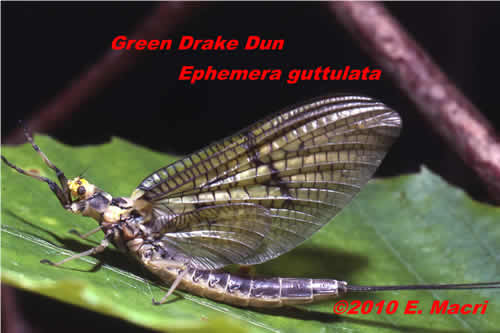
In fact, let me relate a little story about the use of weight and some old fly angler I met on
Penns Creek years ago. It was the beginning of the Drake hatch (Ephemera guttulata) and the
stream was at moderate level but it was very hot. The hordes of anglers had descended upon the stream and in
their usual carnage had made a mess of pounding the water with no flies on the water and an inability to
properly fish the drake nymph. In fact, the Drake was late that year so the swarms of anglers had arrived way
too early but that's part of the drake hatch! It was about 3;00 in the afternoon and we had just nymphed a
stretch below the Rail Road Trestle in open water on the stream. My buddies and I had caught a few fish while no
one else was getting a strike. Before we headed back to camp I decided to try and pull a big fish from the
stretch with a streamer. So I tied on a large Yellow Marabou and added the necessary weight of three small shot up
the leader. I shot the rig all the away across the stream and used the old broadside method of fishing the
streamer to the fish as prescribed by the late great Joe Brooks. On the first cast a dark golden shadow
all of sudden emerged from the bottom of the stream and hammered the fly! After a rather robust and long fight I
landed the wild Penns Creek brown of around 18 inches. I had attracted a crowd of anglers during the tussle
so there were about 6 or 7 fly anglers behind me when my fishing companion Bill Finney netted the trout. It was a
magnificent specimen and an 18 inch brown trout is rather large fish for Penns. However, one rather old
fellow came up to me and looked carefully at the fish. "What the hell did you catch him on?" I showed him the
rig. He bluntly stated anyone who would use a rig like that, ..." You just might as well use dynamite!"
A few days later I spotted the old gent trying to get across the stream. It was difficult because Penns is a
rather tough stream to wade. So I helped him across the stream and showed him a better route for
his return. He than told me, " You know you are not a bad guy for someone who fishes with dynamite!" We
just laughed. So there is just one example of bias but a fun one against going down and getting
them!
Without going into the laws of physics it's usually best to use weight that is round.
Why? It bounces and drifts better without snagging. In certain types of steelhead fishing or large
streamer fishing this may not always apply but for the most part you'll do better with round weights.
However, some anglers believe that it makes more sense to weight the fly. In this case they use strip lead,
copper wire or whatever and tie it to the hook. They then wrap or tie the fly over the weight. There
are good things and bad things that happen with this method. What about those split shot that has those little
pinch on wings for getting them off or on? Stay away them because they seem to not only screw up the
drift but also catch snags like a stripper pulls in dollar bills!!!
So let's start off by understanding what weight really does because it may seem simple enough but
many fly anglers are ignorant of what the advantages and disadvantages are:
-
Adding weight obviously sinks the fly and gets to where the angler wants it if the weight, leader,
and fly are rigged and casted correctly. This is a lot hardier than it looks and we will
discuss these things in a moment.
-
Weight can be used to control the drift. This is important and can be used in a number of
ways.
-
It allows the fish to be hooked easier in many situations! If you don't believe this tie a
fly on a leader. Try striking it against some material. Now try it again with a split
shot on and see which goes in easier and deeper!
-
Weight can be used to control other flies on a tandem or dropper rig.
-
Weight such as copper wire and can be used as a combination body material and to get the fly down.
-
Weight can be used on sections of a fly or with other materials to keep a fly at a certain level or
give the fly a certain action.
-
Weight allows a fly to be cast a certain distance and drifting to a fish that would otherwise be
impossible without it.
Some fly anglers who are not particularly adept at using weight believe you just slop one
on and cast it out there. Usually their results are less than what one would call rewarding. The
amount of weight, the type of weight, the type of leader or tippet and where the weight is attached all make a
difference not to mention the ability of the angler as a caster and fly angler. The real problem with this is that
there is no template that can be used. Each stream is different and each fly and leader combination is
different so the only by trial and learn and lots of different fishing situation does the fly angler figure
out what's best to use and when to use. And that's the rub! Most fly anglers don't want to take
the time to experiment because all our American Mindset is that everything is instantaneous. It takes years
to actually develop a feel for how much weight to use and the best method to use it. (Diagram below shows various elementary rigs use in fishing shot. Notice that the shot can be
moved around and the distance from fly to shot is not in stone and depends on stream type, volume of water and
where you need to get the fly. In the tandem rigs notice the two styles of droppers. In my estimation the
tandem tied to the hook gets down deeper but the old style with the dropper has much more action and you can
manipulate it more)
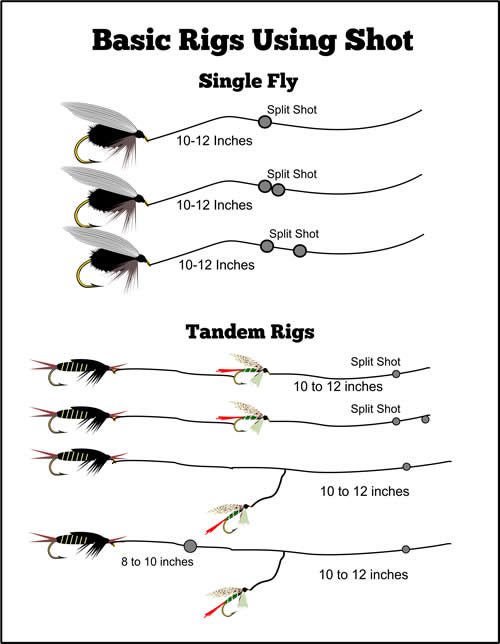
I was one of the first to use small weights and copper wire on the spring creeks in South Central
Pennsylvania. This goes back before there were any flies like the Copper Johns, or Brassies. Most
anglers didn't want to use weight in these streams because of their history and because they didn't understand
it. I developed the sunken spinner , which I showed to Charlie Meck years ago. He wrote about it
in one of his books. It would be great if you didn't have to use weight to fish wet flies or nymphs etc. but
to be truthful there are very few hatches compared to 40 years ago and this means that the trout rise less and
so you either have to get them underneath or take up golf!
There are no fly fishing laws on how to use weight. What works on the Madison River
in Montana won't necessarily work on Falling Spring Run in Pennsylvania. For most nymph fishing I
use the following formula: 1) I have the split shot (amount depends on depth, speed of water etc) about 10 to
12 inches above the bottom or point fly ( this is not in stone..sometimes 6-10 inches may work etc.
depending up depth and flow). I have a variety of shot from micro shot to usually size B. I adjust
accordingly. I use this rig with single flies, tandem and droppers. You can put more than
one shot and how does it spread? Well it depends some days the shot are together; other days I space
them. but obviously, you must cast this carefully. If you have only one fly I like the stop cast where
the fly hits the water and goes right in. This is more difficult with tandems and dropper sometimes because
of wind etc. In this case I sometime sling the rig or flip sideways and I can control the rig with my rod on
entry. Note that in most instances your are not casting a long line. You must be able to control these
rigs to fish properly. I recommend longer rods in the 8.6 to 11 foot range. Lines can be anywhere from 2 to
10 weights depending on where and what you are fishing for.
Other rigging methods include attaching a short tippet to the fly leader with the split shot
on the bottom with flies on separate droppers. This method allows the lead first to go on the bottom and
the flies floating above it. This works especially well on some waters where you want to get the fly
down deeply basically in the lowest zone. If the split shot gets snagged you simply snap off
the that portion of the tippet and flies hopefully are saved above. This method has some caveats too.
One of them is that this tends to be good only for bottom fishing because other drifting scenarios don't work
that well on many streams. Also, on some streams these rig gets tangled more. Variations of these
rigs are often used for Steelhead and Salmon fishing both throughout the US.(In the rig
below the tippet section with the shot must be light enough to break off but also sufficient strength and
diameter to cast properly.)
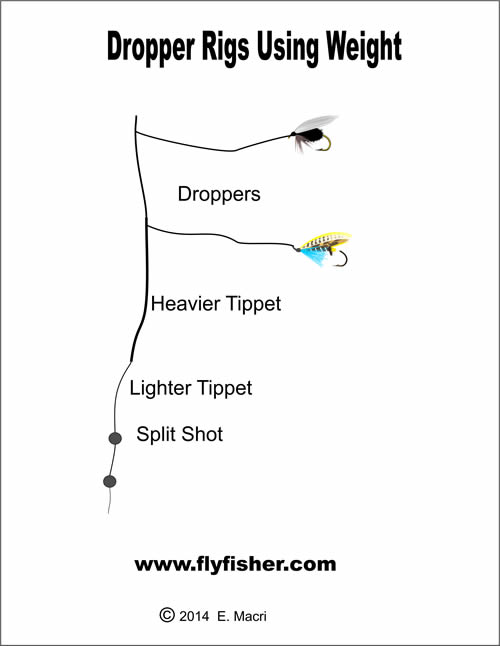
It's important to have the proper leader for any type of nymph fishing. Too long a leader will
defeat the purpose of the weight and you will have a mess. In most instances use a 7.6 to 9 foot
leader. Adjust your tippet and shock leader ( the section above the tippet) to the type, size of fly and the
amount of weight and the depth as well as how you wish to fish. Furthermore, the type of leader material used and
the diameter is important. Some leaders like Flurocarbon are extremely stiff and brittle in my
estimation. You should experiment with different leaders and tippet types til you find out what works for
your situation. (Below is a streamer and wet fly rig. Make sure you have proper
spacing so the droppers don't tangle. Diagram doesn't show that. And make sure the droppers are far enough
away from the streamer to avoid tangling. Droppers should be stiffer than main leader, Bottom dropper should be far
enough up the leader so it doesn't wrap around the shot when drifting. You can also tie this rig with
streamer tied to the shank of the wet fly but I prefer this type for most streamer rigs. Also, you can tie
the streamer and then tie a tandem or single fly off the streamer rig. This works on finicky trout sometimes
especially in pond and lakes.)
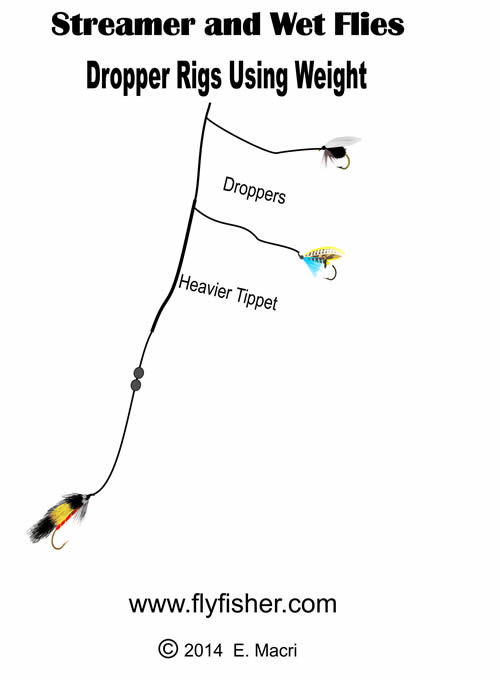
One of the more novel ideas of using a dropper off a dry fly may accomplish a number of
things. Although this has been around a long time most fly angler seldom use it. It works great in
controlling the flies depth, and float pattern underwater. There is the added advantage of using the dry fly
as marker or nymph indicator and there is always the chance you'll take a trout on the top. If you work with
this rig you can pull off some amazing catches. This rig can be use with a variety of patterns from big
Wulffs to a terrestrial on the top and a midge off of it. It's one the best techniques on spring creeks some
days because it keeps the fly at a certain depth that's almost impossible to achieve in any other manner.
Many years ago I observed this technique used on Henry's Lake in Idaho for Trico fishing. Because you had to
cast quite a distance your success rate using the small flies was not very good. Anglers quickly discovered
that they could tie a large dry with a dropper with either a spinner, sunken spinner or trico nymph and reap the
dividends by just watching the dry fly and then striking. Also, I believe it increase the hooking ability of
the small fly when the trout sucks it in and surface tension of the dry fly helps in their demise.
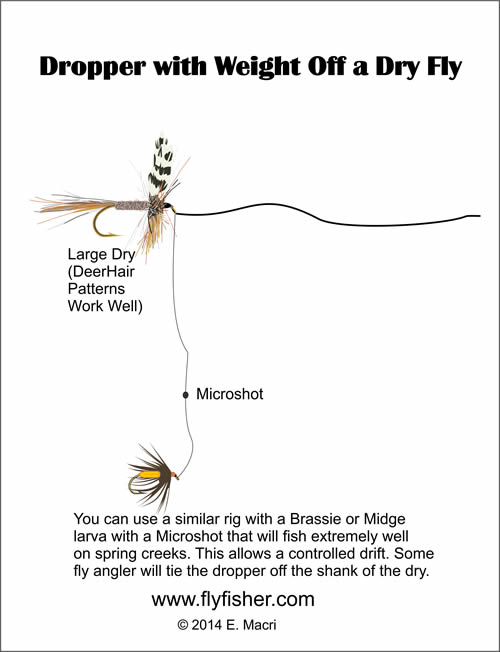
When using weight understand that it can be used not only to get the fly down but to control
the drift. Too many fly anglers don't understand this. Look carefully at the diagram below. I've
watched fly anglers for over 40 years and most don't have a clue to where their fly is! The problem is this:
you have a trout in front of you. You can see the outline of the fish in the fast water. But you really can't
get a cast to get the fly down where you want it because of rocks, currents etc. So most fly anglers don't
ever get the fly in the trout's zone or long enough in the zone. Expert nymph fishermen realize this. For
some the rest of the fly fishing fraternity believes that they can trigger the fish to come out of the pocket and
take the fly. On some occasions you can do this. On most occasions you are dreaming. I'm not going to
go into the energetics theory that many so called expert fly anglers have written about because there is a lot of
nonsense and myth in that mess. However, realize that especially in the spring or in colder water, or when the
stream gets a lot of pressure trout will not move much.
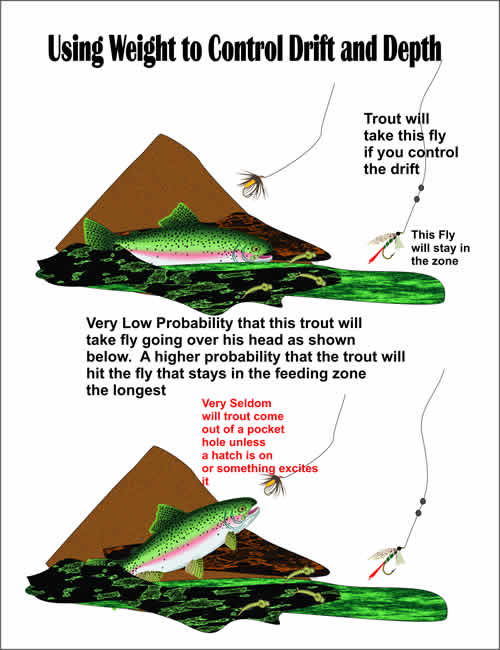
What you must do is add enough weight for the fly quickly to enter the drift area and then
manipulate the drift with the current to keep the fly in the zone. This includes dropping the tip quickly to
get the fly down while tightening the line with your hand and then getting into the proper position. This is
not easy. One of the reasons for the problems is that most fly anglers don't have the reflexes to cast the fly and
get it into the zone! It takes a lot of patience and practice. Another reasons is that many fly anglers won't
use a long rod. Why do you think the European anglers have developed these long light fly rods? It's
not to increase their casting ability; it's for controlling the line, leader and drift. The best method for this is
to use as short a line as possible. Get the fly down swiftly by using a stop check cast and immediately drop
the tip. The secret to fly fishing which no one wants to talk about is control. Many fly anglers will
actually get a strike but it's way too late by the time the see it and react. One of the things I see fly anglers
doing is trying to cast long distances upstream to get a drift down to the trout. First they spook fish
everywhere and second there is no way on a rocky stretch that they are getting near the fish. This may work
on a drift, run or a pool but it's utter chaos anywhere else. I've even seem some guides try this on Big
Spring. They direct their clients to cast 40 and 50 feet upstream over multiple currents and flows they think
they will catch fish.
This is not easy fishing. But if you master controlling a wet fly, nymph, streamer or
whatever with the use of weight from microshot on a spring creek to a "rosary" of shot on a large river you will
catch more fish than you ever dreamed of. I love to fish dry flies for trout including terrestrials on
spring creeks etc but I fished these stream with Fox and Marinaro and I can honestly tell you that I caught the
most and biggest trout with these methods of using weight to control the drift. Most fly anglers don't realize that
weight is the best way to control the drift of a fly. On a spring creek there are very subtle currents on the
surface and a number inches below the surface. Fly anglers throw their flies and don't realize that the fly
does not come into the feeding zone. Part of the problem is where and how you fished most of your life.
On a mountain stream that isn't very rich the trout have larger feeding zone. On streams that are richer
especially bigger waters the trout won't move very far. On spring creeks most days you literally need to put the
fly in the trout's mouth! However, the subtle currents which many fly anglers
don't see play havoc with their drift and ultimately with getting the fish to strike. One of the great
secrets of fishing a spring creek is to get the fly down near
the bottom and then bring it up to the fish! The trout will almost always take the fly!!! By getting your fly
below these currents and bringing it up to the fish you defeat the stream controlling your drift and you literally
steer the fly in the zone you want!
You won't see that in most fly fishing books or articles. It is the
greatest thing you can learn about fishing spring creek with most underwater patterns!!!! What makes spring creek
fishing so great is you can usually see the reaction of the fish. Now think of that same reaction when you can't
see the fish in a riffled section of a stream. Does it make you understand more about how you should be
fishing?
Here's another trick that few fly anglers ever use. It's the use of a floating type fly with a
shot. One of 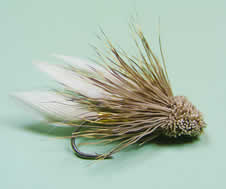 the best is the Muddler Minnow. Most fly anglers never use the Muddler and
don't even carry them. If you use a shot or two above the Muddler (8 to 12 inches) you can get Muddler
underwater and it will bounce around and rise above the bottom without snagging. It's one of the most
effective ways of luring large trout from under obstructions, snags and undercut banks. Of course you can add
a lot weight and fish right on the bottom two but fly anglers are surprised when they see how I fish this
fly. By manipulating your line and lifting your rod you can use this fly in a number of ways due to the
buoyancy and the weight together! the best is the Muddler Minnow. Most fly anglers never use the Muddler and
don't even carry them. If you use a shot or two above the Muddler (8 to 12 inches) you can get Muddler
underwater and it will bounce around and rise above the bottom without snagging. It's one of the most
effective ways of luring large trout from under obstructions, snags and undercut banks. Of course you can add
a lot weight and fish right on the bottom two but fly anglers are surprised when they see how I fish this
fly. By manipulating your line and lifting your rod you can use this fly in a number of ways due to the
buoyancy and the weight together!
I hope you enjoyed this primer on the Art and Science of Fishing Weight. It's actually Part
1. In a future article I may share some of my secrets for really catching tough fish from tough waters and some
imaginative things on how to use the microshot and weight to do it.
| 






 the best is the Muddler Minnow. Most fly anglers never use the Muddler and
don't even carry them. If you use a shot or two above the Muddler (8 to 12 inches) you can get Muddler
underwater and it will bounce around and rise above the bottom without snagging. It's one of the most
effective ways of luring large trout from under obstructions, snags and undercut banks. Of course you can add
a lot weight and fish right on the bottom two but fly anglers are surprised when they see how I fish this
fly. By manipulating your line and lifting your rod you can use this fly in a number of ways due to the
buoyancy and the weight together!
the best is the Muddler Minnow. Most fly anglers never use the Muddler and
don't even carry them. If you use a shot or two above the Muddler (8 to 12 inches) you can get Muddler
underwater and it will bounce around and rise above the bottom without snagging. It's one of the most
effective ways of luring large trout from under obstructions, snags and undercut banks. Of course you can add
a lot weight and fish right on the bottom two but fly anglers are surprised when they see how I fish this
fly. By manipulating your line and lifting your rod you can use this fly in a number of ways due to the
buoyancy and the weight together!